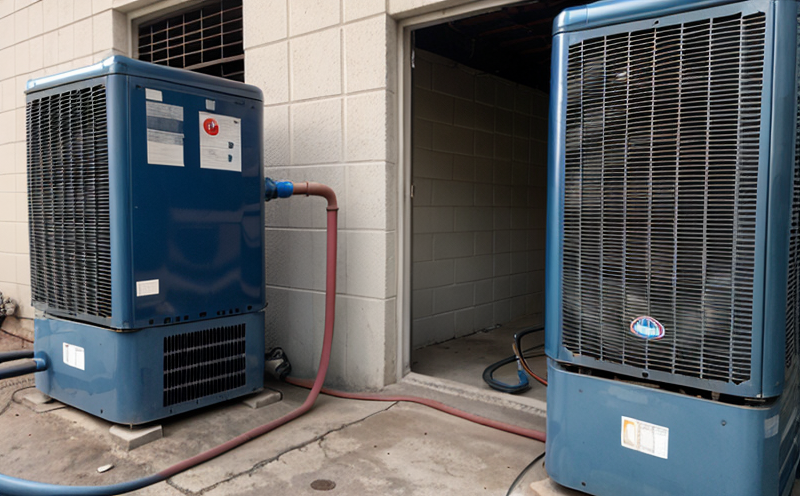District cooling system inspection
The district cooling system inspection is an essential service aimed at ensuring the optimal performance and longevity of large-scale HVAC systems. These systems are pivotal in providing efficient, sustainable, and cost-effective cooling solutions for urban environments where high-density populations and buildings demand significant energy resources.
District cooling networks involve a centralized plant that generates chilled water which is then distributed through an underground pipeline network to various end-user buildings. The system aims to reduce the overall environmental impact by minimizing the need for individual chillers in each building. This approach is particularly beneficial in sectors like commercial, residential, and industrial properties where energy consumption is high.
The inspection process involves a comprehensive evaluation of all components within the district cooling network including chilled water pumps, heat exchangers, condensate systems, and distribution piping. The primary goal is to identify potential issues early on, thereby preventing costly breakdowns and ensuring continuous operation at peak efficiency.
During an inspection, various parameters are measured such as pressure differentials across key components, flow rates through pipelines, and temperature variations within the system. These measurements help in assessing the overall health of the district cooling network and pinpoint any areas that may require maintenance or replacement.
Using advanced diagnostic tools like thermal imaging cameras, acoustic meters, and specialized software for data analysis, inspectors can gather detailed information about the condition of the system components. This data is then used to create a detailed report outlining findings and recommendations for corrective actions if necessary.
| Component | Possible Issues Identified During Inspection |
|---|---|
| Chilled Water Pumps | Worn-out impellers, misalignment, leaks, and bearing wear |
| Heat Exchangers | Clogged or fouled heat exchanger surfaces, cracks in the exchanger plates |
| Condensate Systems | Inadequate condensate collection, blockages in drainage lines |
| Distribution Piping | Corrosion, leaks, and uneven distribution of chilled water |
The quality and reliability of district cooling systems are critical for maintaining sustainable urban environments. Regular inspections play a vital role in ensuring that these systems operate efficiently while minimizing environmental impact.
Benefits
- Increased Efficiency: Identifying and addressing issues early can significantly enhance the performance of district cooling networks, leading to reduced energy consumption.
- Cost Savings: Preventive maintenance reduces the need for emergency repairs, thereby lowering operational costs.
- Sustainability: By optimizing system efficiency, inspections contribute to a greener environment and support sustainability goals.
- Enhanced Safety: Early detection of potential hazards ensures that risks are mitigated before they escalate into serious problems.
In summary, district cooling system inspection services provide tangible benefits in terms of improved efficiency, cost savings, environmental impact reduction, and enhanced safety. These advantages make regular inspections an indispensable part of any comprehensive maintenance strategy for large-scale HVAC systems.
Industry Applications
- Commercial Buildings: High-density urban areas where energy consumption is a significant concern.
- Residential Communities: Large apartment complexes and condominiums that rely on centralized cooling systems for comfort.
- Industrial Parks: Areas with multiple industrial facilities sharing a common district cooling network for efficient resource management.
- Retail Spaces: Shopping centers and malls where maintaining consistent temperatures is crucial for customer satisfaction.
| Application Sector | Specific Considerations |
|---|---|
| Commercial Buildings | Focus on optimizing system performance to meet high cooling demands during peak hours. |
| Residential Communities | Prioritizing comfort and energy efficiency in densely populated areas. |
| Industrial Parks | Maintaining consistent temperatures for industrial processes while minimizing resource usage. |
| Retail Spaces | Ensuring customer comfort while managing operational costs effectively. |
The district cooling system inspection service is applicable across various industries, each with its unique requirements and challenges. By addressing these specific needs, the service ensures that district cooling networks operate at their best, contributing to both economic efficiency and environmental sustainability.
Quality and Reliability Assurance
The quality and reliability of district cooling systems are paramount for maintaining sustainable urban environments. Regular inspections play a crucial role in ensuring that these systems operate efficiently while minimizing environmental impact. Quality assurance is achieved through a combination of advanced diagnostic tools, meticulous documentation, and adherence to international standards.
Advanced diagnostic tools such as thermal imaging cameras, acoustic meters, and specialized software for data analysis are used during the inspection process. These tools provide detailed insights into the condition of system components, enabling early detection of potential issues. The data collected is meticulously documented in a comprehensive report that outlines findings and recommendations for corrective actions if necessary.
Adherence to international standards such as ISO 51910 ensures consistency and reliability in the inspection process. These standards provide a framework for best practices in HVAC system maintenance, ensuring that inspections are conducted in a manner that is both thorough and efficient.
Meticulous documentation of the inspection process is essential for maintaining quality and reliability. This includes detailed records of all measurements taken during the inspection, observations made about the condition of system components, and recommendations for corrective actions. These documents serve as a valuable resource for future reference and ensure that any issues identified are addressed promptly.
The quality assurance process also involves regular calibration of diagnostic tools to ensure accuracy. This is crucial in maintaining reliable data collection during inspections, thereby ensuring the integrity of the inspection reports.
In summary, district cooling system inspections are a critical component of maintaining sustainable urban environments. By adhering to best practices and international standards, these inspections ensure that district cooling networks operate at their optimal performance levels while minimizing environmental impact.





